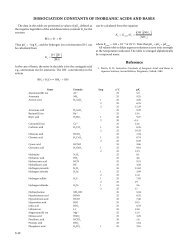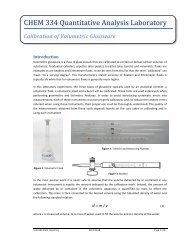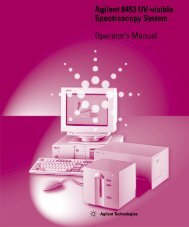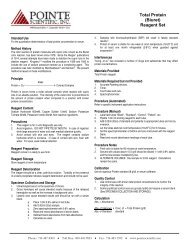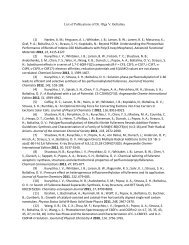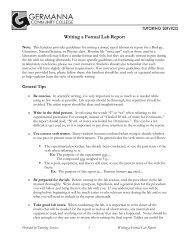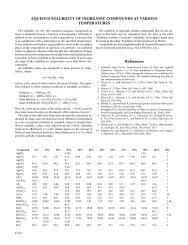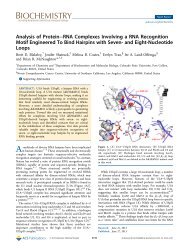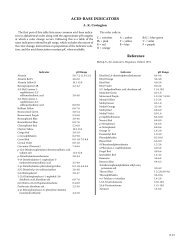1 Notes for Rotational-Vibrational Spectroscopy of 1HCl and 2HCl
1 Notes for Rotational-Vibrational Spectroscopy of 1HCl and 2HCl
1 Notes for Rotational-Vibrational Spectroscopy of 1HCl and 2HCl
You also want an ePaper? Increase the reach of your titles
YUMPU automatically turns print PDFs into web optimized ePapers that Google loves.
Colorado State University<br />
CHEM 475<br />
Physical Chemistry Laboratory - 1<br />
<strong>Notes</strong> <strong>for</strong><br />
<strong>Rotational</strong>-<strong>Vibrational</strong> <strong>Spectroscopy</strong><br />
<strong>of</strong> <strong>1HCl</strong> <strong>and</strong> <strong>2HCl</strong><br />
The following is a set <strong>of</strong> short notes to outline the experiment in question <strong>and</strong> to provide helpful<br />
guidance to those executing the experiment.<br />
A. Heteronuclear atomic molecules provide excellent "test beds" <strong>for</strong> pro<strong>of</strong>ing models <strong>of</strong> the<br />
mechanics <strong>of</strong> atoms in molecules <strong>and</strong> their interaction with electromagnetic radiation.<br />
B. In another experiment in this laboratory, the absorption spectra <strong>of</strong> diatomic molecules<br />
was analyzed <strong>and</strong> predicted by use <strong>of</strong> the "harmonic oscillator" that models the<br />
interatomic distance between two atoms - behavior that gives rise to a varying molecular<br />
electric dipole that ultimately gives rise to an absorption, typically in the IR region.<br />
C. The harmonic oscillator can be improved upon by inclusion <strong>of</strong> the "rigid rotor" model that<br />
together will predict more detailed spectroscopic features.<br />
D. The gas cell used in this experiment is constructed with IR transparent ends (made from<br />
disks <strong>of</strong> NaCl, which is transparent to IR radiation) <strong>and</strong> is several centimeters long to<br />
provide sufficient optical density (absorbance) from the low-density gas. It must be<br />
stored in a desiccator when not in use to prevent "fogging" <strong>of</strong> the water-sensitive NaCl<br />
end plates. It must also be cleaned (flushed out) by gently (!) flowing nitrogen gas<br />
through it while it is in the hood. Collect a background spectrum (use "absorbance"<br />
mode not "percent transmittance") using the nitrogen-cleaned cell.<br />
E. Collect a high-quality IR spectrum <strong>of</strong> 1 HCl gas obtained from a "lecture bottle" (use<br />
"absorbance" mode not "percent transmittance"). Convert the spectrum file to ASCII<br />
<strong>for</strong>mat, transfer it to a suitable computer <strong>and</strong> analyze it with Igor Pro. Repeat this<br />
process until a suitable spectrum is obtained.<br />
F. In order to collect a corresponding spectrum <strong>of</strong> 2 HCl this isotopically substituted<br />
molecule must be prepared in the laboratory. A convenient procedure (with significant<br />
modifications!) <strong>for</strong> this purpose can be found in the textbook "Experiments in Physical<br />
Chemistry" authored by Shoemaker <strong>and</strong> Garl<strong>and</strong>. Flowing <strong>2HCl</strong> gas through it rather<br />
than the vacuum based procedure described in the textbook fills the two-valve cell used<br />
in this laboratory.<br />
G. Estimate the volume <strong>of</strong> the cell filling apparatus (to the ±20% level - do not<br />
overestimate) from the round-bottom generating flask to <strong>and</strong> including the cell itself<br />
(apparatus "down wind" from the cell is inconsequential). Use a convenient volume<br />
CHEM 475 - <strong>Rotational</strong>-<strong>Vibrational</strong> <strong>Spectroscopy</strong> 2014.10.07 Page 1 <strong>of</strong> 2
etween two <strong>and</strong> three times this estimate to ensure that a sufficient quantity <strong>of</strong> 2 HCl is<br />
generated to flush the cell adequately.<br />
H. Calculate the amount <strong>of</strong> benzoyl chloride <strong>and</strong> deuterated water needed to generate the<br />
needed amount <strong>of</strong> 2 HCl.<br />
I. Collect a high-quality IR spectrum <strong>of</strong> 2 HCl gas obtained (use "absorbance" mode not<br />
"percent transmittance"). Convert the spectrum file to ASCII <strong>for</strong>mat, transfer it to a<br />
suitable computer <strong>and</strong> analyze it with Igor Pro. Repeat this process until a suitable<br />
spectrum is obtained.<br />
J. Analyze both spectra using Igor roughly according to the Shoemaker <strong>and</strong> Garl<strong>and</strong><br />
procedure. Since the procedure was written prior to the widespread availability <strong>of</strong> high<br />
per<strong>for</strong>mance computers <strong>and</strong> s<strong>of</strong>tware it used certain outdated conventions. For example,<br />
identify the absorption maxima wavelengths <strong>and</strong> plot them (rather than the nearestneighbor<br />
wavelength differences). Fit these spectra, separately to both second <strong>and</strong> third<br />
order polynomials to extract the experimental values <strong>of</strong> parameters to use in the model.<br />
Per<strong>for</strong>m a suitable F-Test on the extracted values to determine if the third order<br />
polynomial fit is statistically more significant than the second order one. Complete the<br />
analysis as described in the procedure.<br />
CHEM 475 - <strong>Rotational</strong>-<strong>Vibrational</strong> <strong>Spectroscopy</strong> 2014.10.07 Page 2 <strong>of</strong> 2




